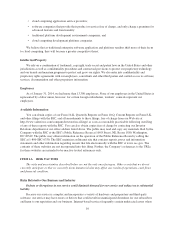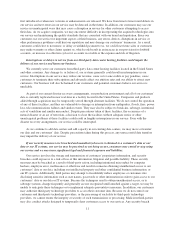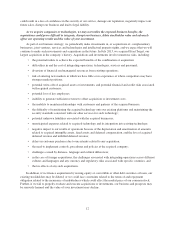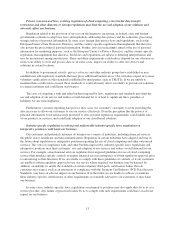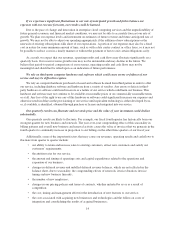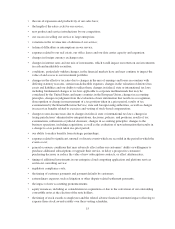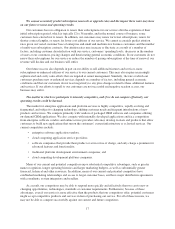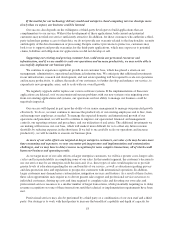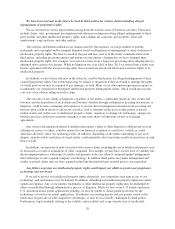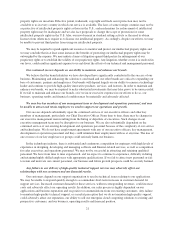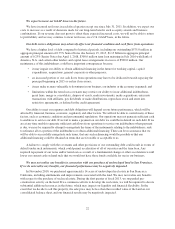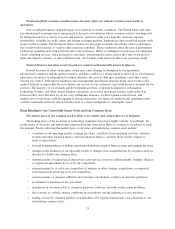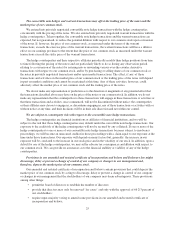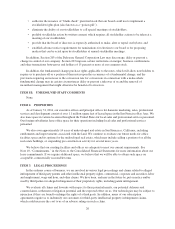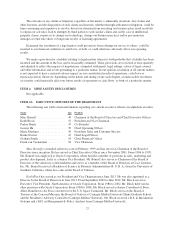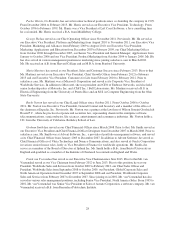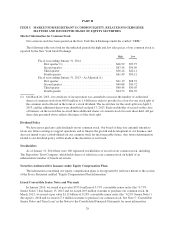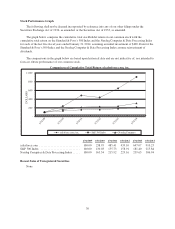Salesforce.com 2014 Annual Report Download - page 24
Download and view the complete annual report
Please find page 24 of the 2014 Salesforce.com annual report below. You can navigate through the pages in the report by either clicking on the pages listed below, or by using the keyword search tool below to find specific information within the annual report.We have been and may in the future be sued by third parties for various claims including alleged
infringement of proprietary rights.
We are involved in various legal matters arising from the normal course of business activities. These may
include claims, suits, government investigations and other proceedings involving alleged infringement of third-
party patents and other intellectual property rights, and commercial, corporate and securities, labor and
employment, wage and hour, and other matters.
The software and Internet industries are characterized by the existence of a large number of patents,
trademarks and copyrights and by frequent litigation based on allegations of infringement or other violations of
intellectual property rights. We have received in the past and may receive in the future communications from
third parties, including practicing entities and non-practicing entities, claiming that we have infringed their
intellectual property rights. For example, we received a notice from a large non-practicing entity alleging that we
infringed upon certain of its patents. While no litigation was ever filed, in May 2013 we entered into a multi-year
license agreement with the non-practicing entity that covered past period and future non-exclusive rights to its
intellectual property.
In addition, we have been, and may in the future be, sued by third parties for alleged infringement of their
claimed proprietary rights. Our technologies may be subject to injunction if they are found to infringe the rights
of a third party or we may be required to pay damages, or both. Many of our subscription agreements require us
to indemnify our customers for third-party intellectual property infringement claims, which would increase the
cost to us of an adverse ruling on such a claim.
The outcome of any claims or litigation, regardless of the merits, is inherently uncertain. Any claims and
lawsuits, and the disposition of such claims and lawsuits, whether through settlement or licensing discussions, or
litigation, could be time-consuming and expensive to resolve, divert management attention from executing our
business plan, result in efforts to enjoin our activities, lead to attempts on the part of other parties to pursue
similar claims and, in the case of intellectual property claims, require us to change our technology, change our
business practices and/or pay monetary damages or enter into short- or long-term royalty or licensing
agreements.
Any adverse determination related to intellectual property claims or other litigation could prevent us from
offering our service to others, could be material to our financial condition or cash flows, or both, or could
otherwise adversely affect our operating results. In addition, depending on the nature and timing of any such
dispute, an unfavorable resolution of a legal matter could materially affect our future results of operations or cash
flows or both.
In addition, our exposure to risks associated with various claims, including the use of intellectual property, may
be increased as a result of acquisitions of other companies. For example, we may have a lower level of visibility into
the development process with respect to intellectual property or the care taken to safeguard against infringement
risks with respect to the acquired company or technology. In addition, third parties may make infringement and
similar or related claims after we have acquired technology that had not been asserted prior to our acquisition.
Any failure to protect our intellectual property rights could impair our ability to protect our proprietary
technology and our brand.
If we fail to protect our intellectual property rights adequately, our competitors may gain access to our
technology, and our business may be harmed. In addition, defending our intellectual property rights may entail
significant expense. Any of our patents, trademarks or other intellectual property rights may be challenged by
others or invalidated through administrative process or litigation. While we have some U.S. patents and many
U.S. and international patent applications pending, we may be unable to obtain patent protection for the
technology covered in our patent applications. In addition, our existing patents and any patents issued in the
future may not provide us with competitive advantages, or may be successfully challenged by third parties.
Furthermore, legal standards relating to the validity, enforceability and scope of protection of intellectual
20


